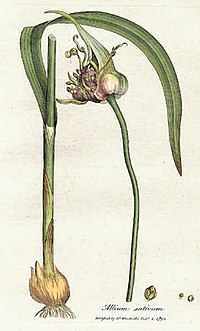
Photo from wikipedia
Garlic (Allium sativum L.) and other species of genus Allium are popular vegetables and food seasonings, owing to their spicy flavour and richness in health-promoting compounds. Several local garlic types… Click to show full abstract
Garlic (Allium sativum L.) and other species of genus Allium are popular vegetables and food seasonings, owing to their spicy flavour and richness in health-promoting compounds. Several local garlic types are still grown on a small scale in different Italian regions, not being however yet properly characterised for their chemical composition. In the present investigation ten garlic and four elephant garlic (Allium ampeloprasum L.) populations cultivated in northern and central Italy were evaluated for their alk(en)yl cysteine sulphoxide (ACSO) and volatile compound profiles. Three non-volatile ACSOs (methiin, alliin, and isoalliin) and twenty-seven volatile compounds were identified and quantified. A high and significant within-type variability was detected, with total ACSOs in the range 2759-5756, 4533-15520, and 6565-10643 mg kg-1 of fresh weight (f.w.). in elephant, white and red garlic, respectively. Elephant garlic showed a total sulphoxide content and a relative alliin amount significantly lower than white and red garlic. Remarkable within-type differences were also assessed for volatile compound content, ranging from 260-599, 333-981, and 618-845 mg kg-1 f.w. in elephant, white, and red garlic, respectively. Diallyl trisulphide was the major individual compound, accounting for more than 0.30 mg mg-1 of volatiles in all the analysed samples. The three garlic types were clearly separated by discriminant analysis of analytical traits. This study investigated for the first time different Italian garlic and elephant garlic populations with respect to non-volatile and volatile organosulphur compound content, allowing the possibility of selecting garlic accessions according to the bioactive content. This article is protected by copyright. All rights reserved.
Journal Title: Journal of the science of food and agriculture
Year Published: 2022
Link to full text (if available)
Share on Social Media: Sign Up to like & get
recommendations!